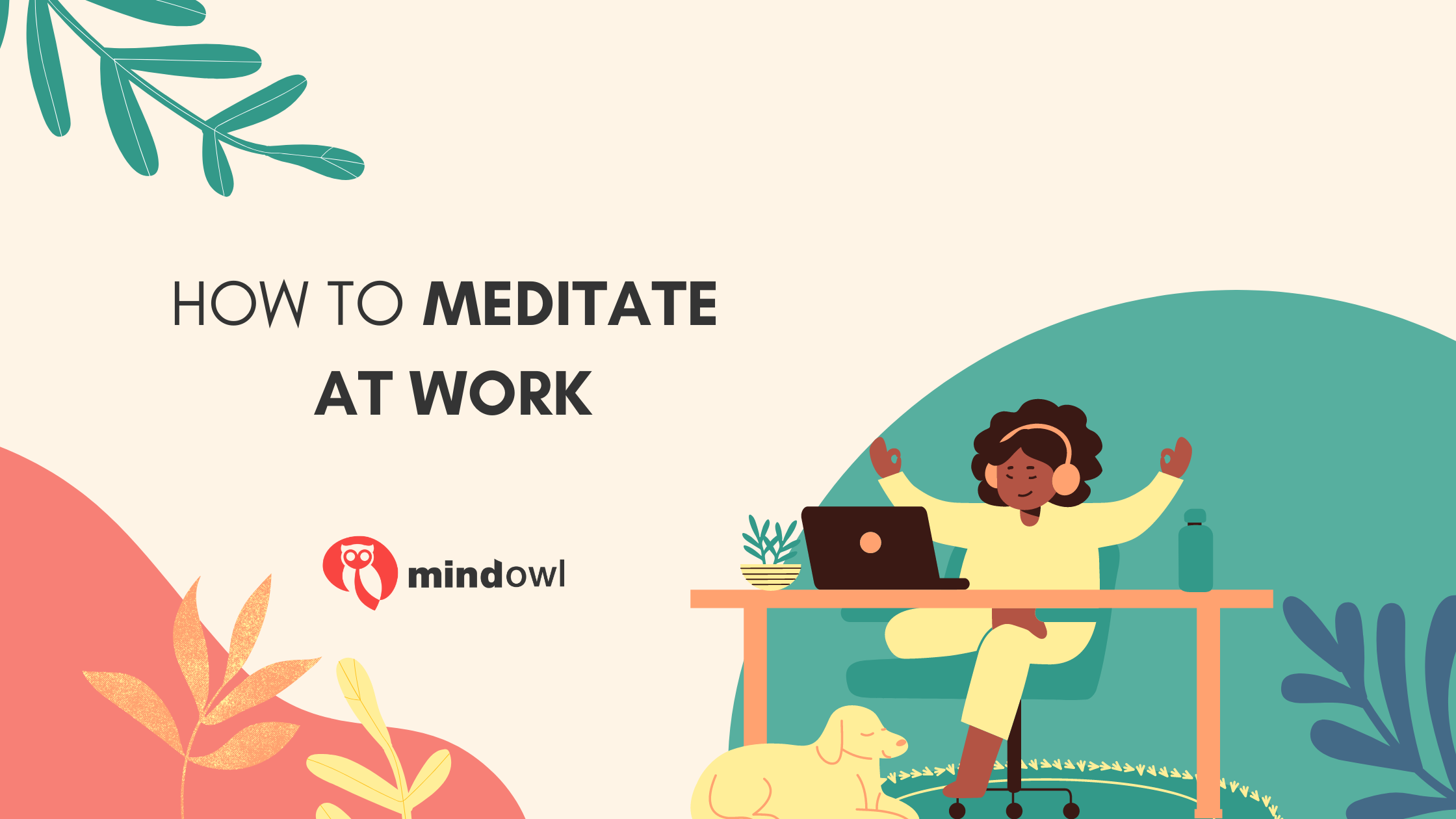Should you meditate at work? It is undoubtedly the case that the events of the past year or so have greatly affected the way we work. And now, over a year on from the beginning of the Covid-19 pandemic, many of us are still in very unfamiliar working environments. Whether you are working from your home, or have begun the move back into an office with colleagues, there is no denying the fact that you will have to spend a considerable amount of time in work mode.
It was very common to feel stress or anxiety even before the additional uncertainty of the pandemic was introduced into our lives, so it is entirely expected that we will be feeling a heightened level of unpleasant emotions now. If you are looking for a little bit of extra support throughout your working day then there is one simple step that you can take to look after your mental health: meditation.
You may be familiar with meditation as a formal practice. Maybe you even have your routine, where you set aside half an hour, turn your phone to silent mode and truly dedicate this time to your meditation practice. It might seem counterproductive to practice in the middle of an office setting, or while writing an important email to your boss. But in reality, we can meditate just about anywhere, doing just about anything. And by meditating while we work we can both increase our productivity, and establish a healthier mindset towards our work and professional lives.
Why meditate at work?
As we have just discussed, it may be against everything you’ve learned about meditation up until this point to meditate while working. So, can you really meditate at work, and why exactly are we advising you, or rather encouraging you to do this?
You spend a lot of time there
Throughout the Covid-19 pandemic, many of our working routines have become very different and even unbalanced! Whether you work in an office space with colleagues, or at home by yourself, you will undoubtedly spend a huge amount of time in a working environment. Either option provides its own unique set of challenges, whether that is from restrictions that we must all respect while out in public spaces, or from the shift to working without colleagues around you, and in a space that is not necessarily set up for work. Because of this we know, it is more important than ever that we take particular gentle care of our mental health now.
You don’t need to set aside time
Meditation at work can be done while writing, reading, walking or talking. We are not advising you to take huge numbers of breaks, rather you can practise mindful awareness as you work. This means that there will be no hit to your productivity, and you can avoid increased stress further down the road when you have to explain to your boss why you haven’t been completing your work. Incorporating simple meditation techniques in your everyday work routine will support the betterment of your mental health as well as help you perform better at work.
Meditation decreases stress
85% of the time, people are unaware of their emotions and lives, allowing themselves to be driven by their stress. Meditation during the working day can help you to keep on top of your stress levels, among many other health benefits. Rather than allowing them to overwhelm you, meditation gifts you the opportunity to check in on yourself at regular intervals.
Experimenting with repeating a silent mantra( a type of meditation) – on your way to work, at your desk or at home – to help prepare you to perform your best, or even reassure yourself that you turning up and doing your best is enough. Choose a phrase that works best for you, “relax” or “I can do it” and once you have repeat it to yourself internally, in synchronisation with your breath. You can relax your body and mind while preparing for what is coming next at work.
It will improve your work
Not only will meditation allow you to create an awareness of your mind throughout the day, but it will also work to re-centre you on your work. You will find that you can focus more easily, you will feel more creative, deadlines will not cause you to panic, and your problem-solving abilities will be enhanced. This is all due to an increased feeling of capability that a regular form of meditation gives you.

How do you meditate at work?
The question now is of course, how do I meditate while at work? Again, we’re not condoning taking lots of breaks during your working day, (as much as we’d like to). Instead, there are things that you can do while you work to improve your mental health, and to spend the time at your desk – or wherever you happen to be working – wisely. Below I’ve listed some of the most effective ways to incorporate short meditations into your working day.
Animated videos are also a great way to learn how to meditate at work. These videos provide visual cues and guidance, making it easier for beginners to understand the concept of meditation and how to practice it. Animated videos can be found on various websites, such as YouTube, and can be used as a tool for learning the basics of meditation. Additionally, these videos can be used as a form of relaxation or stress relief during breaks from work.
Mindfulness Meditation
To meditate mindfully, all you really need to do is divert all you focus on to one thing. This is actually a great tool to improve productivity – so if you’re a boss, you might want to start taking some notes now. As an example, the health care company Aetna saved over $6 million after implementing a mindfulness program one year ago.
This may seem like an oversimplified explanation of mindful meditation, but once you begin to practise you will notice that it can be tricky at times. Before you begin your day, allow yourself five minutes to a talk on mindfulness, say on a meditation app.
After this what we suggest, is that when you come to start your next task in your working day, attempt to focus solely on that task. You will experience your attention wandering, but whenever you notice that your thoughts have moved to what’s for dinner tonight, or the lovely sunny weather outside, gently guide it back to the task at hand. Eventually, you will grow your ability to remain focussed for longer and longer periods.
Mindfulness practices ( and other forms of meditation) can be used when you are doing anything and do not mean that you are neglecting the task. In fact, it means you are attempting to give the task your entire attention, noticing all the small details that happening around you. By remaining in the now, you will be able to quell the worrisome thoughts and distractions that usually take up so much space in your mind.
Breathing exercises
Another way to mindfully meditate is to focus on your breath. Although this does require your focus to be directed at one anchor, it gives you more of an opportunity to calm your thoughts than simply mindfully being aware of the email you are writing, or the colleague you are speaking to. Maybe try mindful breathing exercises when you feel particularly overwhelmed, or stressed. One exercise you can try is box breathing, which helps to slow down your heart rate and calm your mind and body at the same time. You must inhale for five to six seconds, hold your breath for five to six seconds, then exhale for five to six seconds before repeating the process. You should visualize a box in your mind while you breathe in this way; one side when you inhale, one side when you hold, another when you exhale, and the final side when you hold again..
Body scan
Completing a body scan on yourself can be a great method of re-centring your attention to the current moment. You can complete a full-body scan while sitting at your desk and can keep your eyes open if this is more comfortable for you.
Simply begin by becoming aware of all the sensations in the top of your head, and move your awareness all the way down your body, until you reach your toes. While you increase your body awareness, identify where you feel tense – while sitting at a desk many of us can experience tension in our jaws, shoulders and backs. If you do feel any tightness or tension, attempt to breathe deeply into this area, and relax it. Body scans are another example of how a simple practice can present a wonderful opportunity to re-focus our attention on the present moment. This will help to reduce our feelings of stress and help us to gather our focus effectively on the task at hand.
Loving-kindness
Loving-kindness meditation (a form of compassion meditation) is especially easy to perform while in an office setting. We can do this by setting a rule; after every phone call we make in the day we will take a moment to wish the person we were speaking to well, or each time a colleague walks past our desk we will say a silent hope that they experience love and happiness in their life. A huge part of mindfulness is training our minds not to view the world with judgement. By practising loving-kindness we can teach our minds to express caring, warm thoughts rather than judgemental ones.
Walking Meditation
Whether you work from home or in an office environment, you can complete a walking meditation at any point in the day. The idea is to go for a walk, and while you walk notice the feeling of the floor under your feet. Once you have become fully aware of this sensation, try to shift your awareness up into your ankle, then your legs and knees, and up into your hips. If you are restricted to your desk during the day, try to take a walk on your break and try this practice then. This daily meditation will allow you a moment to release the tension built up in your body.

Conclusion
Meditation is one of the best things you can do to improve your productivity, prevent burnout, and relieve stress. It helps individuals become more aware of their bodies and minds, and gives them the chance to improve their relationships with themselves and others. By spending less time on the daily tasks that don’t bring you any value, you have more time to spend on the tasks that do. This in turn gives you more satisfaction and energy in daily life.
Desk meditation, though on the surface can seem less than ideal, is actually just as essential to our meditation journey as our structured meditation session practices. It gives us the opportunity to take a moment in our busy day, and truly re-centre ourselves. So, what are you waiting for? Next time you sit at your work desk, give meditation a try.
MindOwl Founder – My own struggles in life have led me to this path of understanding the human condition. I graduated with a bachelor’s degree in philosophy before completing a master’s degree in psychology at Regent’s University London. I then completed a postgraduate diploma in philosophical counselling before being trained in ACT (Acceptance and commitment therapy).
I’ve spent the last eight years studying the encounter of meditative practices with modern psychology.

